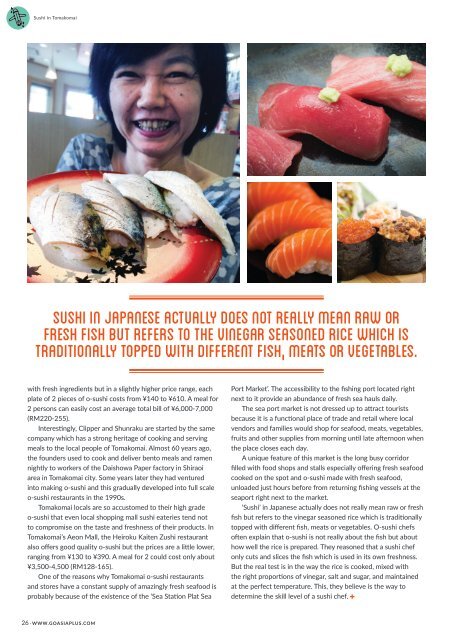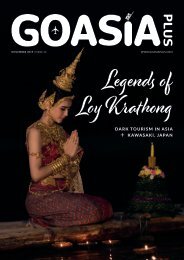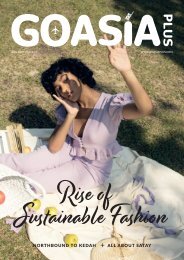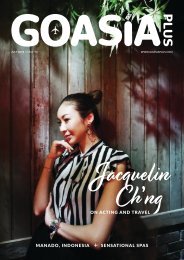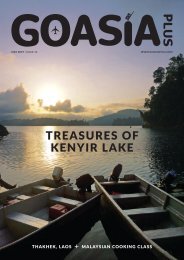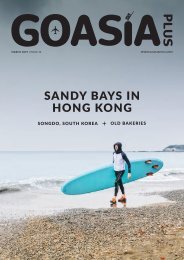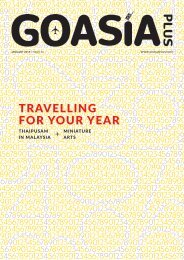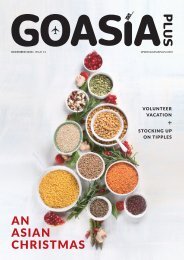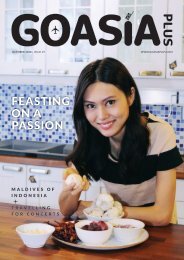GOASIAPLUS June 2018
Since its World Environment Day on 5th June, we explore the green resort of Eight Acres in Raub, Pahang for a sustainable staycation. For the month of festivity, this issue features rendang, the delight of Hari Raya and modern batik wear for local men. More travelling voyage covers sushi in Tomakomai, Japan and Inle Lake in Myanmar.
Since its World Environment Day on 5th June, we explore the green resort of Eight Acres in Raub, Pahang for a sustainable staycation. For the month of festivity, this issue features rendang, the delight of Hari Raya and modern batik wear for local men. More travelling voyage covers sushi in Tomakomai, Japan and Inle Lake in Myanmar.
Create successful ePaper yourself
Turn your PDF publications into a flip-book with our unique Google optimized e-Paper software.
Sushi in Tomakomai<br />
‘Sushi’ in Japanese actually does not really mean raw or<br />
fresh fish but refers to the vinegar seasoned rice which is<br />
traditionally topped with different fish, meats or vegetables.<br />
with fresh ingredients but in a slightly higher price range, each<br />
plate of 2 pieces of o-sushi costs from ¥140 to ¥610. A meal for<br />
2 persons can easily cost an average total bill of ¥6,000-7,000<br />
(RM220-255).<br />
Interestingly, Clipper and Shunraku are started by the same<br />
company which has a strong heritage of cooking and serving<br />
meals to the local people of Tomakomai. Almost 60 years ago,<br />
the founders used to cook and deliver bento meals and ramen<br />
nightly to workers of the Daishowa Paper factory in Shiraoi<br />
area in Tomakomai city. Some years later they had ventured<br />
into making o-sushi and this gradually developed into full scale<br />
o-sushi restaurants in the 1990s.<br />
Tomakomai locals are so accustomed to their high grade<br />
o-sushi that even local shopping mall sushi eateries tend not<br />
to compromise on the taste and freshness of their products. In<br />
Tomakomai’s Aeon Mall, the Heiroku Kaiten Zushi restaurant<br />
also offers good quality o-sushi but the prices are a little lower,<br />
ranging from ¥130 to ¥390. A meal for 2 could cost only about<br />
¥3,500-4,500 (RM128-165).<br />
One of the reasons why Tomakomai o-sushi restaurants<br />
and stores have a constant supply of amazingly fresh seafood is<br />
probably because of the existence of the ‘Sea Station Plat Sea<br />
Port Market’. The accessibility to the fishing port located right<br />
next to it provide an abundance of fresh sea hauls daily.<br />
The sea port market is not dressed up to attract tourists<br />
because it is a functional place of trade and retail where local<br />
vendors and families would shop for seafood, meats, vegetables,<br />
fruits and other supplies from morning until late afternoon when<br />
the place closes each day.<br />
A unique feature of this market is the long busy corridor<br />
filled with food shops and stalls especially offering fresh seafood<br />
cooked on the spot and o-sushi made with fresh seafood,<br />
unloaded just hours before from returning fishing vessels at the<br />
seaport right next to the market.<br />
‘Sushi’ in Japanese actually does not really mean raw or fresh<br />
fish but refers to the vinegar seasoned rice which is traditionally<br />
topped with different fish, meats or vegetables. O-sushi chefs<br />
often explain that o-sushi is not really about the fish but about<br />
how well the rice is prepared. They reasoned that a sushi chef<br />
only cuts and slices the fish which is used in its own freshness.<br />
But the real test is in the way the rice is cooked, mixed with<br />
the right proportions of vinegar, salt and sugar, and maintained<br />
at the perfect temperature. This, they believe is the way to<br />
determine the skill level of a sushi chef.<br />
26 · WWW.<strong>GOASIAPLUS</strong>.COM


